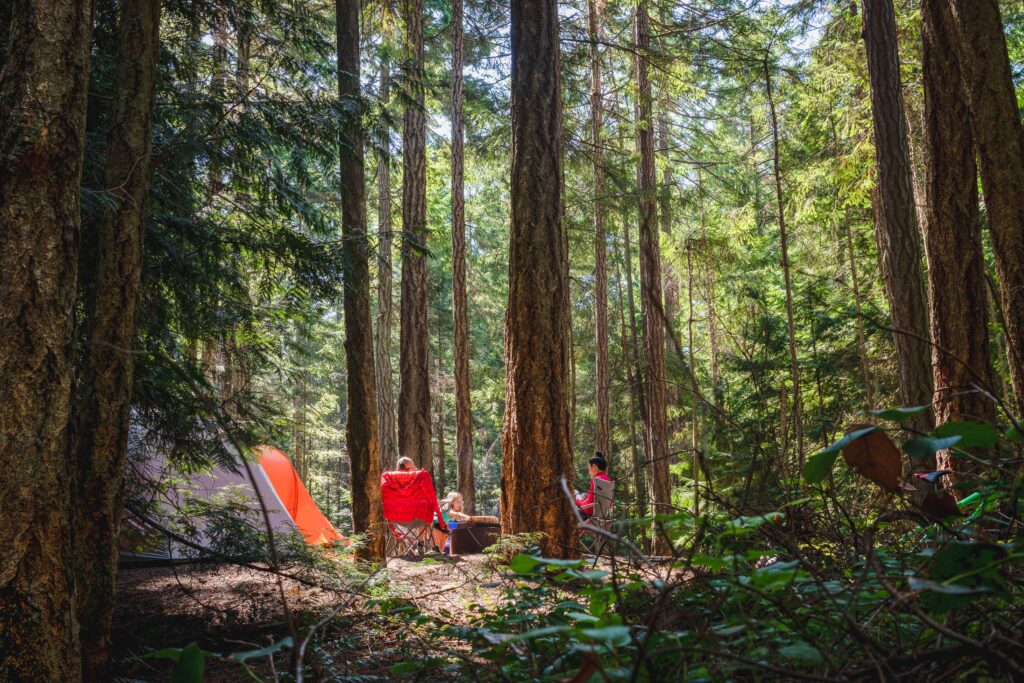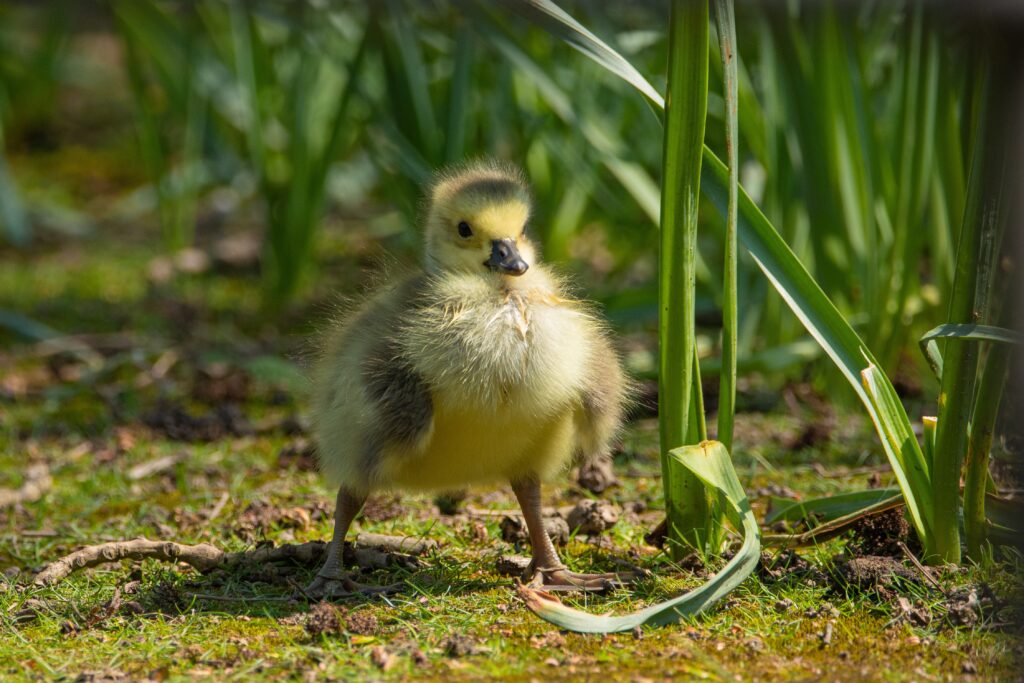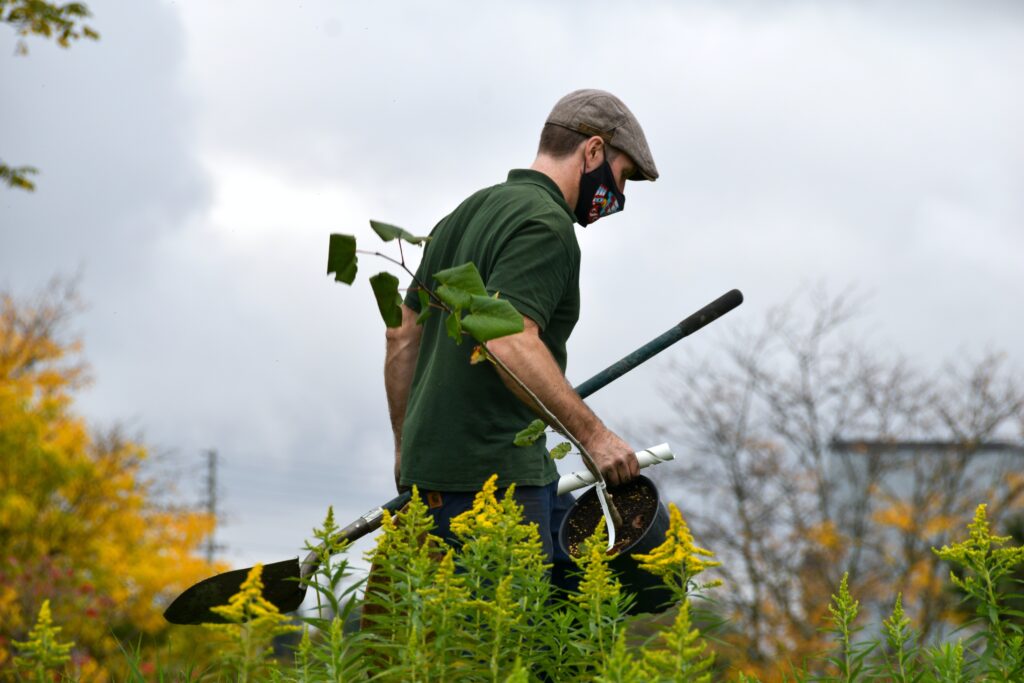Whether you’re visiting Canada on vacation this summer, or looking to explore your own backyard, Canada has an endless amount of eco-friendly travel activities to enjoy. Canada is full of natural beauty, from the Rocky Mountains in the west, to the rolling hills and stunning coastal cliffs to the east. You’d need a lifetime and a much longer list to explore everything. But as you explore and adventure through all that Canada has to offer, it’s important to remember to be mindful of the environment and the impact you leave as you go. From sustainable accommodation to farm-to-table experiences, we round up 7 eco-friendly activities to explore Canada sustainably this summer.

1. Camping, Glamping and Sustainable Accommodation
The first on our list of eco-friendly activities is one of Canada’s most popular outdoor activities – camping. According to the Worldwide Camping Index, Canada is the best place in the world to go camping. It takes the top spot for its beautiful scenery, abundance of national parks, stargazing potential, low pollution and low risk of natural disasters. Camping is one of the best ways to enjoy Canada and also happens to be one of the most eco-friendly, low-footprint, travel activities.
Parks Canada lists over 10,000 campsites across the country so you’ll be sure to find one to suit your needs. If you’re an expert camper and looking to get out into the wilderness, you can also buy backcountry camping passes from Parks Canada.
Glamping (glamourous camping) can take your camping trip up a notch, while still offering many of the eco-friendly and nature-filled benefits of camping. From wood cabins to luxury tree-houses, you don’t have to stick to a tent to enjoy some nature in Canada. Falling under sustainable accommodation, many glamping sites are also eco-friendly, including products and promoting services from the local community.
How Camping and Sustainable Accommodation Helps The Environment
Reduce Environmental Impact
Many sustainable accommodations, from camping to eco-hotels, are designed to minimize their impact on the environment. This can include waste reduction initiatives, water conservation, renewable energy use and recycling programs. These initiatives work to lower the accommodation’s overall carbon footprint and help conserve natural resources.
Promote Preservation
Camping and glamping sites are often located in or beside beautiful forests, beaches or mountains, encouraging an appreciation for nature. In fact, research shows that spending time in nature increases your pro-environmental attitudes and behaviours (PEAB).
Support Local Communities
Many glamping and sustainable accommodations source products and promote services within the local community. They also often educate visitors, providing awareness for local conservation efforts and encouraging a sustainable way of living.

2. Indigenous Craft Workshops
There’s more than 1.67 million Indigenous people in Canada, including more than 630 First Nation communities, representing over 50 Nations and languages. Indigenous peoples in Canada have been protecting and living in harmony with nature for centuries through their understanding of local ecosystems, knowledge and traditional practices.
The Indigenous Arts Collective of Canada has an amazing list of Indigenous artists that offer educational craft workshops. Showcasing Indigenous cultures and ancient art forms, these one of a kind workshops encourage a connection to your environment and Mother Earth.
How Indigenous Craft Workshops Help The Environment
Support Indigenous Communities
Indigenous peoples are the best stewards of our environment but they’ve faced numerous challenges in the last 150 years in Canada. Acknowledging these unique challenges and barriers, supporting the education and awareness of traditional practices and crafts helps to support local Indigenous communities and provide sustainable economic development.
Preserve Cultural Heritage
Workshops can contribute to the preservation of cultural heritage by teaching traditional crafting techniques that have often been passed down through generations. These workshops help preserve the knowledge of traditional techniques and practices, promoting a sense of cultural continuity.
Deepen Your Connection To Nature
Many Indigenous artists and craft workshops highlight the connection between Indigenous cultures and the natural world, emphasizing the importance of environmental stewardship and promoting respect for the environment. Participating in a workshop can help you gain a deeper understanding of Indigenous cultures and their relationship with the environment, sustainable practices and encourage a greater appreciation for the natural world.

3. Sustainable Food Tours and Farm-To-Table Experiences
Next on our list of eco-friendly activities to explore this summer are sustainable food tours and farm-to-table experience. They say one of the best ways to experience a culture is to eat its food. So maybe one of the best ways to experience Canada sustainably is through its locally-sourced, sustainable food. From coast-to-coast, Canada has plenty of sustainable food tours and farm-to-table experiences to enjoy a variety of different dishes.
How Sustainable Food Tours and Farm-To-Table Experiences Help The Environment
Reduce Carbon Footprint
Sustainable food tours and farm-to-table experiences typically focus on locally-sourced, seasonal ingredients. This lowers transportation costs and the carbon emissions that comes with transporting food long distances.
Support Sustainable Agriculture
Sustainable agriculture improves the natural environment, protects the farmers, their employees and local communities and safeguards the welfare of all farmed species. Sustainable food tours and farm-to-table experiences support sustainable agriculture by promoting small-scale farming and supporting local communities.
Reduce Food Waste
One third of food is wasted before it even gets to the kitchen table. But farm-to-table experiences often focus on reducing food waste by creatively using every part of each ingredient. This eco-friendly strategy helps reduce the amount of food going to waste, ending up in landfills and contributing to greenhouse gas emissions.

4. Birdwatching and Birding Tours
Birdwatching is popular in Canada with almost 40% of the population watching or caring for birds around their home. Canada also ranks as the 13th happiest country in the world and according to recent research, the more bird species you see the happier you are. We’re not saying birds are the reason for Canada’s high happiness levels, but we’re not not saying it. Those two facts exist. And you can do with them what you will.
Birdwatching tours are available all over the country and with 703 bird species in Canada there’s plenty to try and spot. Birdwatching might even become one of your favourite eco-friendly activities. Keep an eye out for events and festivals around the year like the Festival of Birds in Ontario, and the Wings Over The Rockies Festival in British Columbia, both in May.
How Birdwatching Helps The Environment
Increased Awareness
Birdwatching and birding tours are excellent opportunities to learn about different bird species, their habitats and the role in the ecosystem. Learning about birds can help deepen your appreciation for nature, connection to the environment and maybe even inspire conservation preservation.
Habitat Preservation
Birdwatching and birding tours can help promote natural habitat preservation. The economic benefits of sustainable tourism often help strengthen the case for continued conservation efforts and preservation of bird habitats.
Citizen Science
Birdwatching and birding tours are a great opportunity to collect some data on birds. Data collected from Citizen Scientists contributes to research and monitoring programs and can help inform conservation efforts. Birds Canada has a great list of Citizen Scientist programs across the country to explore.

5. Organic Wine Tasting And Vineyard Tours
Canada might not make the top ten list for best wine country but thanks to Ontario’s Niagara Peninsula and British Columbia’s Okanagan Valley it still makes it to the number 28 spot for global wine production. So if wine is your thing, touring some of Canada’s sustainable vineyards might be the eco-friendly activity for you this summer.
Organic and natural wine has been growing in popularity in Canada for the past few years. Organic grapes make up about 5% of all grapes in Canada and are mostly grown in British Columbia, Ontario, Quebec, and Nova Scotia. While there’s no list of organic wineries in Canada, the Organic Council of Ontario provides a list of regional resources to find organic producers and wineries.
How Organic Wine Tasting And Vineyard Tours Help The Environment
Organic Farming Practices
Organic vineyards rely on natural farming methods and avoid using synthetic pesticides, fertilizers and growth regulators. Natural farming methods include crop rotation, animal manure and mechanical cultivation.
Biodynamic farming goes a step further. Biodynamic farmers observe and work in balance with nature, treating their farm like a living system.These farmers account for the rhythms of nature, might make their own compost and observe nature to know when to do it.
Water Efficiency
Soil is king in organic farming and healthy soil holds water well, reducing the need for extensive watering in dry conditions. Organic farms have more water in their soil than conventional farms, and use natural methods to conserve water where possible. Methods like cover cropping and no-till agriculture are used to help prevent run-off and soil erosion, and rainwater is captured and reused where possible.
Increased Biodiversity
Thanks to natural farming methods and avoidance of pesticides, organic farming can increase biodiversity in an area by about 30%. For wine making, biodiversity supports vine vitality with some organic vineyards in Canada encouraging butterflies, bees, birds, small mammals and even lambs in their vineyards.

6. Forest Bathing
The next on our list of eco-friendly activities to explore in Canada is forest bathing. Developed in Japan in the 1980s, forest bathing, or shinrin-yoku, is the practice of “taking in the forest atmosphere” and is a form of eco-therapy. Research shows that spending time in nature is good for us and has positive physiological and psychological effects on our bodies. Walking around a forest can reduce stress, lower blood pressure and increase your energy levels. As a low carbon impact activity, forest-bathing is a great eco-friendly activity to enjoy this summer.
How Forest Bathing Helps The Environment
Appreciation For Nature
Spending time in nature can help you gain a deeper appreciation for the environment by exposing you to the plant and animal species around you and the value they bring to your local ecosystems. Increasing your awareness of these species can help strengthen your understanding of how to better protect and conserve their natural habitats.
Inspire Sustainable Living
Forest bathing can lead to a greater understanding of the interconnectedness of ecosystems and the impact human actions can have on the environment. This increased awareness can inspire people to make more eco-friendly choices, value natural environments and support conservation efforts.

7. Tree Planting and Reforestation Volunteering
Last on our list of eco-friendly activities to explore this summer is tree planting and reforestation volunteering. Canada is known for trees, in fact it has 30% of the world’s forests. But tree cover in Canada has decreased 11% since 2001, 50% of this loss is across British Columbia, Quebec and Saskatchewan.
Trees provide a host of environmental benefits from filtering water to absorbing carbon dioxide from the atmosphere. Not to mention, they also provide a food source and habitat for native animal species to live.
Organisations like Trees Canada and One Tree Planted provide information on how to get involved in local tree planting and reforestation programs across the country. You can volunteer individually or as part of a group as a sustainable activity this summer, or anytime time of year.
How Tree Planting And Reforestation Volunteering Helps The Environment
Water Management
Trees help with water management by absorbing, holding and filtering water. In fact, trees are made up of 50% water. They absorb falling water through their leaves, preventing run-off. Water is held in their roots helping slow down water streams and subsequent soil erosion. Without trees managing water in the environment, soil would become drier and more prone to drought and erosion during extreme flooding events.
Soil Health
In addition to helping prevent soil erosion, trees also help improve soil health. They add new organic matter through fallen leaves, moderate soil temperature by providing shade and their roots break up and aerate soil for new growth.
Carbon Sequestration
Trees can help in the fight against climate change by removing carbon dioxide (CO2) from our atmosphere. The larger the tree, the more carbon it can sequester. Canada’s managed forests alone have removed an average of 180 million tonnes of CO2e per year. Volunteering at tree planting and reforestation programs, can help increase the number of Canada’s trees and the amount of carbon captured from the atmosphere.
Sustayn is designed to present the most useful recommendations for environmentally friendly approaches and items. We update links when possible, but note that links can be broken and subject to change.









1 comment
ulfm3u